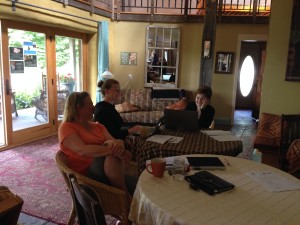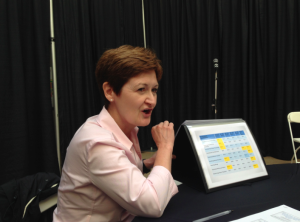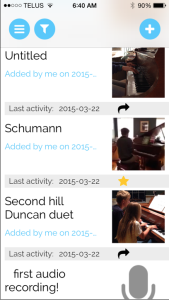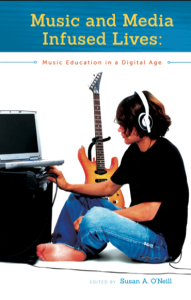The post International Music Survey appeared first on The Suite.
]]> Today’s the day! We’ve just launched what promises to be the biggest survey to date of students, teachers, and parents involved in studio music instruction for instrument and voice. The survey, launched on October 30, will close on December 18.
Today’s the day! We’ve just launched what promises to be the biggest survey to date of students, teachers, and parents involved in studio music instruction for instrument and voice. The survey, launched on October 30, will close on December 18.
In 2014, we conducted a national survey with students involved in Canada’s Royal Conservatory; now we’re expanding our research to look at students involved in 12 conservatories and schools in English-speaking countries following a conservatory system.
The surveys are designed to help us better understand the experiences revolving around studio instruction. What do students find most challenging in terms of practising between lessons? What strategies do they use to become more self-regulated as learners? What kinds of repertoire and genres do they enjoy most? How do parents contribute to the musical development of their children? Do parents who have played an instrument or sing do things differently than parents who don’t play or sing? And what about the teachers? How big are their studio practices? How long have they been teaching? In what ways do they think that technology might be able to help them engage their students? What kinds of professional development appeal to them most? These are but a few of the questions that we’ll be asking! We will be sharing the results widely, with the partnering institutions, of course, but also through papers and conferences. The surveys have been granted clearance according to the recommended principles of Canadian ethics guidelines. While we will be gathering information from individuals, we will only report on groups; all answers will be kept confidential.
Here are the partners — from Canada, the UK, Ireland, the United States, and Australia! We expect the survey to reach students in Malaysia and Singapore as well. Learn more about all of these fine organizations by clicking on the name to reach their website.
Associated Board of the Royal Schools of Music • Australian Music Examinations Board • Birmingham Conservatoire • Conservatory Canada • MacPhail Center for Music • Music Teachers National Association • Royal Conservatoire of Scotland • Royal Irish Academy of Music • Royal Northern College of Music • Royal Welsh College of Music & Drama • San Francisco Conservatory of Music • The Royal Conservatory
The link to the Teacher Survey is here:
http://www.surveygizmo.com/s3/2179593/Music-Teacher-Survey
The link to the Parent Survey is here:
http://www.surveygizmo.com/s3/2179027/Parent-Survey
The link to the Student Survey is here:
http://www.surveygizmo.com/s3/2179469/Music-Student-Survey
The post International Music Survey appeared first on The Suite.
]]>The post DREAMing Big! DREAMing easy. appeared first on The Suite.
]]>Specific searches are simple – resource submissions are individually checked for quality, which means no more cute cats’ orchestrated improvisations or semi-skilled preschoolers whacking away at Rachmaninoff’s “Prelude in C-sharp Minor” (not that DREAM is without humour or entertainment factor – try searching, “Rachmaninoff Had Big Hands”)
Just looking for inspiration? Wondering what are other users have uploaded or mass favourited? (yes, that is now a word) At the top of DREAM’s new-and-improved home page, you’ll see two wide tabs – Recent Additions, and Most Popular. They’re a good way to start exploring DREAM, and under the Most Popular tab, I just now discovered some lovely Anne Crosby repertoire I’ve actually got on my studio shelf but never got around to playing through – lucky September students!
Also at the top of the home page, you’ll see a large “search” bar. Feeling like your instrument is under represented? I just typed in “t” and DREAM suggested “Flight of the tuba bumblebee”, and “Suite for Unaccompanied Tuba”. Looking for a clarinet concerto for one of your young prodigies? Start typing in “clar-“, and the ever-helpful predictive typing will likely fill in the “-inet” part for you, and give you a long drop-down list of clarinet-related options. Do I hear a cheer from the hunt-and-peck typists in the crowd? Seriously, though, fewer keystrokes means a quicker search, and I’m all in favour of that when it’s “five minutes to student” and I’m still lesson prepping. A cute additional feature: if you look carefully to the far right of the search bar, there’s a teeny blue bouncing ball that, to me, makes DREAM look eager and poised for action!
The post DREAMing Big! DREAMing easy. appeared first on The Suite.
]]>The post Happy Birthday DREAM! appeared first on The Suite.
]]>The post Happy Birthday DREAM! appeared first on The Suite.
]]>The post On the Learning Curve – Behind the Scenes appeared first on The Suite.
]]>Our first afternoon brought the early arrivals and, after a lovely supper created by Wintergreen Studio’s talented chefs, Diane Black and Hayden Rasberry, we did a quick overview of the year past, including Jodie Compeau’s very well received presentation of DREAM to CFMTA National Conference attendees in Vancouver, and Rena Upitis’ DREAM presentation in Spain at e-Learning 2015. It seems the University of Milan is interested in setting up a pilot program with their teachers. How exciting, to watch our Canadian music technology going global! Closer to home, we welcomed new Camerata members, Karen Boese of Queen’s University and Nathalie De Grace, recipient of last year’s fellowship grant. Nathalie described some of her extensive experiences using iSCORE (yes, it’s still very much alive!) with her students at CEGEP in Quebec. Stay tuned for September’s detailed blog of Nathalie’s iSCORE use in the classroom.
Roused early from our beds Friday morning by the sound of breakfast preparations, we wandered into the kitchen, following the call of fresh-made coffee. There was a load of work to be done…but not yet. A meal prepared by Diane and Hayden can’t be rushed.
It was still early, but once breakfast was finished, everyone was keen to get started on the day’s tasks. Even 7-month old Milo, the youngest Camerata member (shown here with Julia Brook), was literally jumping up and down on Papa Joe Ferretti and Mama Elaine Lau’s laps as Rena took the floor to set out the day’s agenda.
By 8:30a.m., we’d started into the nitty gritty of DREAM v.2 with a vengeance! It’s fascinating to be a cog in the intricate gear works required to keep the DREAM database user friendly, efficient, and growing by anywhere from 10 to 70+ new, high-quality submissions a month! I’d like to pass along the top two requests from DREAM “vetters” to you, the critically-needed and much-appreciated submitters:
- please include as much information in your submission title as possible – full title, instrument highlights (eg, bassoon concerto), choir or orchestra conductor. The DREAM search engine works best with lots to work with!
- Try to submit only professional-callibre recordings. The team was a bit torn on this issue – we’re nearly all teachers and want to encourage young talent – but decided YouTube and Vimeo were still better venues for budding musicians
The Camerata machine chugged on through the morning, and we worked our way down the agenda to NoteMaker, one of the two apps I mentioned in the spring blog, and an integral part of what I’m hoping will become fundamental to my students’ weekly lessons and mid-week check in’s. Sneak peek: if all goes as planned, we’ll have professional-development videos and online materials soon, to make this easy-to-use app even more useful to “in the trenches” teachers.
Noontime brought a luncheon with guest of honour Dr. Julia Brook and many of her friends and colleagues to celebrate her new position of Assistant Professor at the School of Music, Faculty of Arts and Science, Queen’s University. Congratulations, Julia!
Work picked up again into th e afternoon as everyone broke up into pairs and small groups to inspect and make suggestions for three upcoming international surveys for teachers, parents, and music students, similar to the one recently conducted here in Canada.
e afternoon as everyone broke up into pairs and small groups to inspect and make suggestions for three upcoming international surveys for teachers, parents, and music students, similar to the one recently conducted here in Canada.
I won’t go into any more Camerata secrets here – stay tuned for more blogs in the next few weeks. Before winding up, though, I want to express how happy I am to be part of such an amazing project. I mean, where else can you leave your workaday studio life to spend 2-3 days being pampered and fed, surrounded by gardens and wildlife, brainstorming with such a wonderful group of people well into the evening, and often with chocolate and a lovely glass of wine? No doubt about it, it’s a tough job but, as they say, somebody’s gotta do it!
The post On the Learning Curve – Behind the Scenes appeared first on The Suite.
]]>The post DREAM-ing in Spain appeared first on The Suite.
]]>Rena Upitis presenting DREAM at e-Learning
We’ve just returned from the international e-Learning conference held in Las Palmas, Spain. It was an amazing gathering – an intense several days, with very focused and engaged participants. We presented a paper on DREAM, highlighting the ways that this music tool has been used since its release less than a year ago. The paper also discussed ways that DREAM is being enhanced – Version 2 will be released in August!
There was a poster session as well, leading to one of the very exciting developments at the conference – a series of discussions with a professor from the University of Milan and his colleague from the Italian Ministry of Education. Both of our Italian colleagues were keen to explore ways to use DREAM to support the music curriculum in Italy. We’ll be pursuing that possibility this fall.
We’re extremely pleased that the music tool is attracting such interest for both teachers and researchers. Our sense is that there are several reasons for this attraction. Perhaps the most important reason is that the resources in DREAM have been vetted for quality: teachers can find wonderful examples of repertoire, apps and games, and professional resources without spending endless hours conducting Google searches or viewing YouTube videos.
 There are now over 4,000 resources available on DREAM. This is a bilingual tool (French and English). And perhaps it will also be available in Italian if all goes well!
There are now over 4,000 resources available on DREAM. This is a bilingual tool (French and English). And perhaps it will also be available in Italian if all goes well!
The post DREAM-ing in Spain appeared first on The Suite.
]]>The post On the Learning Curve – The Home Stretch! appeared first on The Suite.
]]>Sanity Saver
http://www.dreammusictool.ca/my-music-staff
Switching to a web-based studio management system has been a game changer for me, and business expenses are all well and good, but I’m seriously considering switching to these folks. I’m paying “the competition” over $30 a month, and that’ll take a $20 leap as soon as I stop juggling my head count to stay at 40 students. Ouch! My Music Staff charges $12.95/month for unlimited students. Just add another $3.95 each for additional teachers. It also offers similar features including: automatic invoicing, student information and event management, calendar, online payment option, and website/blog setup for studio teachers, mileage and expenses tracker for income taxes, and student portal, plus additional perks like drag and drop RCME repertoire and etudes for student practice logsHmmmm. Not bad.
Fun & Foolishness

http://www.dreammusictool.ca/victor-borge-improvising-anton-kontra
Always entertaining, Mr. Borge is just fun to watch, but his improvisation also illustrates the importance of having a good technical toolbox to draw from on the fly. Cadences, chord progressions, arpeggios, chromatic scales – he throws them all into the pot!
http://www.dreammusictool.ca/victor-borges-hillarious-hungarian-rhapsody-piano-duet
Victor Borge does his impish best (worst?) to “play nicely with others” in a piano duet of Liszt’s Hungarian Rhapsody No. 2. This might be fun to arrange for an advanced-level performance piece!
http://www.dreammusictool.ca/rachmaninoff-had-big-hands

Rachmaninoff had big hands. Igudesman & Joo demonstrate a hilarious small-hands solution to playing Rachmaninoff’s Prelude in C# minor.
Creative Relaxation
http://www.dreammusictool.ca/orphion
To some, Orphion might be a pretty time waster,  but as a somewhat self-critical piano teacher, I enjoy simply “noodling around” on an unfamiliar instrument (or app), without being hampered by my advanced-pianist expectations. This is a lovely little app with far more scope than I had time to explore.
but as a somewhat self-critical piano teacher, I enjoy simply “noodling around” on an unfamiliar instrument (or app), without being hampered by my advanced-pianist expectations. This is a lovely little app with far more scope than I had time to explore.
“Orphion is a musical instrument with a unique sound between string instrument and percussion. Everyone can play expressive, wonderful sounds and easy or virtuosic melodies on it just by moving fingers on virtual pads.
- Express the sounds you feel
- Play polyphonic music very expressively
- Crazy drumming
- Dream and relax
- Create soundscapes and melodies without musical knowledge
- Visually explore music and music theory
- Use Orphion’s innovative interface to play other synth apps via MIDI”
The post On the Learning Curve – The Home Stretch! appeared first on The Suite.
]]>The post Congress — CSSE appeared first on The Suite.
]]>
 Members of our research team have been presenting papers at the Congress: Canadian Society for the Study of Education (CSSE), which is taking place at the University of Ottawa. Our papers are based on our project findings, including data from our studio case studies as well as the national surveys that were conducted in 2014. Karen Boese and Julia Brook presented a paper titled Growing Alone: Examining Professional Development for Independent Music Teachers. Another paper examined artistry in music teaching. Both papers were well received, and we were delighted to meet new colleagues wrestling with some difficult questions in music and arts education.
Members of our research team have been presenting papers at the Congress: Canadian Society for the Study of Education (CSSE), which is taking place at the University of Ottawa. Our papers are based on our project findings, including data from our studio case studies as well as the national surveys that were conducted in 2014. Karen Boese and Julia Brook presented a paper titled Growing Alone: Examining Professional Development for Independent Music Teachers. Another paper examined artistry in music teaching. Both papers were well received, and we were delighted to meet new colleagues wrestling with some difficult questions in music and arts education.
The post Congress — CSSE appeared first on The Suite.
]]>The post On the Learning Curve — Spring Babies! appeared first on The Suite.
]]> I’ll return us to our regularly-scheduled blog in a couple of weeks, but in honour of spring officially having sprung, I’ve got a really BIG announcement: In just a few months (7 to be exact), there are going to be two new babies in our midst! Not to be outdone by Gwyneth Paltrow and her little “Apple”, their names will be Notemaker and Cadenza. Our little musical bundles of joy will be making their debut to the general public in December 2015 and April 2016 respectively. It sounds like a long way away, but trust me, the wait will be worth it! These two will be the younger siblings of big sister iSCORE, who found her teaching niche in the classroom. Cadenza and Notemaker, however, will be revamping how we teach in our private studios.
I’ll return us to our regularly-scheduled blog in a couple of weeks, but in honour of spring officially having sprung, I’ve got a really BIG announcement: In just a few months (7 to be exact), there are going to be two new babies in our midst! Not to be outdone by Gwyneth Paltrow and her little “Apple”, their names will be Notemaker and Cadenza. Our little musical bundles of joy will be making their debut to the general public in December 2015 and April 2016 respectively. It sounds like a long way away, but trust me, the wait will be worth it! These two will be the younger siblings of big sister iSCORE, who found her teaching niche in the classroom. Cadenza and Notemaker, however, will be revamping how we teach in our private studios.
I’ve been a teacher advisor on the iSCORE/Cadenza/Notemaker project (now called MEDA – “Music Education in the Digital Age”) for several years now and watched iSCORE give us a look into some exciting advancements to the future of music teaching. She also provided many frustrations and growing pains trying to convince her to fit our private-teacher agendas and wish lists. Now that iSCORE has found her best fit, MEDA is focusing on realizing our teacher wishes through Cadenza and Notemaker.
It’s fascinating to see the stages of app development close up. Notemaker is the first “baby” to see the functional mockup/feedback stage. Still in the functionality testing and tweaking stages, it’s already cute as a button and easy to use. Once it’s done, it will be the app part of the duo that, most importantly, will enable students to effortlessly record and upload high-quality video and audio, and upload pre-recorded videos to their google drives, among other fun and useful features. By December, it should be ready for delivery.
Now in the interactive-storyboard stage, little Cadenza is looking really exciting! Taking off where iSCORE stopped, it’s designed to be used by teachers to create e-dictation book notes during lessons, with general and specific goals and practice-tactic suggestions. Teachers will be able to specify practice goals such as “three times perfectly in a row” or “five times this week”, etc. Students will use Cadenza from their devices to log practice times and specifics of what they practiced, and the system will record the details for teachers to see on their own “teacher” Cadenza pages. Though it’s hard to pick just one feature, I think my current favourite for student fun factor are the system rewards for achieving goals set during that week’s lesson. Yay cyber trophies! Back to the teacher perspective, we’ll be able to see an overview of students’ practice during the week, make general or specific to-do “cyber-post-it” style notes to ourselves, and zoom in to see practice specifics for each student. My favourite practical feature will be a carry-over from iSCORE – the ability to view and make text comments on students’ videos uploaded via Notemaker. Is the student still playing a wrong note *here*? We’ll be able to mark for the student exactly where it’s happening. Hopefully, by the time we see them for their next lesson, the error won’t be ingrained by days of incorrect practice! Because of its more streamlined, intuitive design, Cadenza will be easier and quicker to use than older-sister iSCORE, and midweek checks will take moments to do and make our in-person lesson time more productive.
Do you have anything you’d like to share from your own teacher wish list? What would make your life easier as a teacher? What would make your students’ lives easier or motivate them to practice more and better? I’ll pass any feedback on to the developers – now is the time to shout out!
The post On the Learning Curve — Spring Babies! appeared first on The Suite.
]]>The post On the learning curve … Rhythm Help appeared first on The Suite.
]]>“Wonder of wonders, miracle of miracles!” One of my students actually got perfect marks across the board on her recent Grade 1 sight and ear exam components, including an examiner comment of “outstanding sight reading.” I haven’t been at this music-teaching career for as long as most of my peers, but so far this 17th year is proving to be the most successful one yet!
That said, a big challenge I’m still bumping up against is something that comes so naturally to most musicians including myself—basic pulse sense. It’s tough to teach what you can’t imagine not understanding! From producing a steady beat, to feeling the pull of that root pulse and using it to anchor more complex rhythms, everything unravels without that ingrained pulse sense. Once that’s in place, in theory, it’s just a matter of sensing and placing the subdivisions in the right places via numeric counting or some variation of syllabic chanting (tah, ti-ti, pie, ap-ple, etc). Like J. S. reputedly said, just “play the right note at the right time.” Easier said than done?
Here are some more DREAMy resources ready to augment your metronomes, marching, tapping and chanting activities.
Apps
http://www.dreammusictool.ca/most-addicting-sheep-game
For iPhone and iPad
 “Run, jump, and roll in the easy-to-learn, tricky-to-master most addicting sheep game…. It’s an engagingly simple rhythm platform where jumps and rolls must be perfectly timed to the music to complete the increasingly complex levels with maximum score. Oh, and it has a cute sheep.”
“Run, jump, and roll in the easy-to-learn, tricky-to-master most addicting sheep game…. It’s an engagingly simple rhythm platform where jumps and rolls must be perfectly timed to the music to complete the increasingly complex levels with maximum score. Oh, and it has a cute sheep.”
From a teaching perspective, this app exercises steady beat skills in combination with visual and motor coordination to navigate the arcade-style levels – from basic one-finger pulse tapping to challenging single-finger taps, multi-finger taps, and side-sweep “rolls”, alone and in combination. I’ll have to test its actual effectiveness with my students, but it definitely looks worth the small investment! Appropriate for beginners and up.
http://www.dreammusictool.ca/rhythm-cat-pro-learn-read-music
For iPhone, iPad, and Android (see DREAM app comments for android link)
“A fun game that will help kids and adults learn to read some basic music rhythms. 60 entertaining levels that get progressively more challenging.”
In the early levels of each lesson unit, this game supports steady-beat sense and develops hand-ear coordination as students tap basic beats and rhythms along with the music and the score. In each lesson’s higher levels, the music is removed and only the drum track and score remain – students must rely on their rhythm-reading skills to advance. Appropriate for beginners to early advanced level. NOTE: I would definitely recommend investing in the “Pro” version to access levels beyond mature-beginner difficulty.
http://www.dreammusictool.ca/rhythm-trainer
For Android
This is exactly what the name says—a good no-frills rhythm trainer. This free app comes with 8 levels of difficulty, ranging from simple quarter notes and quarter rests, half notes and rests, to single eighth-note and eighth-rest combinations. For $1.49, you can unlock the remaining levels to work up to sixteenth notes and eighth-sixteenth combinations. Using a very uncomplicated approach, the app plays a continuous metronome and counts you in, plays the rhythm shown on the screen, and you just tap what you hear and see. Didn’t get it the first time….or the 10th? No worries, it will repeat and repeat – with feedback on where you went wrong – until you master it.
Videos and Webpages
http://www.dreammusictool.ca/beat-vs-rhythm
This is a great idea for one-on-one or group beginner lessons. One person takes the role of “cave man” (bucket optional, lol) and plays the steady beat, and another does the rhythm on top. Thank you, Cherie Herring, for my next group activity!
http://www.dreammusictool.ca/dont-clap-one-back
Another fun activity for one-on-one lessons or group classes, and customizable to many levels—the leader claps a series of rhythms to the partner or group, but one of the rhythms is the “don’t clap this one back” pattern, so listen carefully! The site offers free guide sheets and rhythm cards as well, to help you make this as much a rhythm-reading exercise as an aural one.
P.S. I’ve been wracking my brain to find solutions to the perennial “I can’t remember the beginning after I’ve listened all the way to the end” rhythm-clapback issue, but so far I’ve come up empty handed. I’d love to hear any suggestions or solutions you might have, digital or otherwise!
Happy Nearlyspring!
The post On the learning curve … Rhythm Help appeared first on The Suite.
]]>The post New book in the CMEA/ACME Biennial Series appeared first on The Suite.
]]> Music and Media Infused Lives, edited by Susan O’Neill, explores significant opportunities, challenges, and responsibilities facing learners, educators, researchers, and musicians in today’s digital age. Increasingly affordable, accessible, portable, and interactive forms of digital media technologies are interwoven into the musical practices of our everyday lives, providing opportunities for more people than ever before to experience diverse and dynamic ways of engaging with music. And yet, the mere presence of technology does not guarantee effective music education in classroom or community contexts. This book provides wide-ranging insights by authors from Canada and around the world for stimulating dialogue and critical understanding, and for harnessing the full potential of digital media technologies in education.
Music and Media Infused Lives, edited by Susan O’Neill, explores significant opportunities, challenges, and responsibilities facing learners, educators, researchers, and musicians in today’s digital age. Increasingly affordable, accessible, portable, and interactive forms of digital media technologies are interwoven into the musical practices of our everyday lives, providing opportunities for more people than ever before to experience diverse and dynamic ways of engaging with music. And yet, the mere presence of technology does not guarantee effective music education in classroom or community contexts. This book provides wide-ranging insights by authors from Canada and around the world for stimulating dialogue and critical understanding, and for harnessing the full potential of digital media technologies in education.
See the Music and Media press release for further information, or access the Canadian Music Educators Association website.
The post New book in the CMEA/ACME Biennial Series appeared first on The Suite.
]]>
